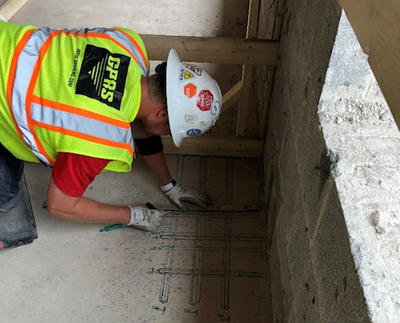
Concrete Scanning at Penn State in Pennsylvania
Background:
Ground Penetrating Radar Systems (GPRS) was contacted by Clayco, Inc (a Construction Engineering Company) regarding the 4th phase of the East Hall’s demo and renovation project in State College, Pennsylvania. This phase entailed renovating Sproul Hall (10 floors) and Geary Hall (7 floors) at Penn State University. The renovation would include running new electrical conduit and plumbing from the basement up through all floors in each building. The scope consisted of scanning approximately 210 locations in Geary Hall and 250 in Sproul Hall, prior to core drilling. Geary Hall consists of a 13-inch waffle slab, while Sproul Hall is an 8-inch slab with two layers of rebar. Sam Hart, project manager for GPRS in central Pennsylvania, worked closely with Clayco to coordinate scheduling for the work completed. The scanning started in July and will be completed by September of 2019. The buildings first had to go through abatement, demolition and then the scanning took place. After the top and bottom rebar is marked out, the contractor could then submit their proposed core drilling locations for approval.
The Challenge:
In Geary Hall, a 13-inch waffle deck made up the concrete slab. The majority of the core drilling locations take place along the perimeter of the exterior wall. The locations are in the 13- inch structural slab between the waffle and exterior wall. This area consists of 3 top rebar and 3 bottom rebar with 3-inch spacing running parallel to the exterior wall. The electricians were drilling between the exterior wall and first rebar, so this had to be verified as well as any rebar running perpendicular to the wall. The plumbers and mechanical contractors were drilling a 5-inch hole in most locations. Consequently, they could not avoid all 3 rebar on the top and bottom layers. Therefore, the structural engineer allowed them to drill through the middle bar while avoiding the two other rebar. In Sproul Hall, the slab is approximately 8 inches thick and the rebar is spaced approximately 6 to 8 inches. This allowed for more options when it came to the drilling process, however the contractor still had to strike minimal rebar when drilling.
Results:
This is now the 4th phase that GPRS and Clayco have worked together in this process. The holes are checked after the core drilling has taken place to ensure no additional rebar have been disturbed. To date, all core drilling locations were drilled without an issue, in a timely and flawless manner. GPRS was able to provide multiple project managers on-site when needed, to keep the project on schedule.
The Solution & Benefits:
The solution was for Sam to arrive on site find and pinpoint the reinforcement along the perimeter of the building using the StructreScan Mini XT GPR unit. Sam did just that, in an appropriate and non-invasive manner. All markings were made in real time and GPR data was recorded daily, for report writing. It is never safe to assume that embedded objects such as conduits, rebar, and post tension cables do not exist when core drilling, saw-cutting, or chopping concrete. Contact Ground Penetrating Radar Systems prior to using any of these methods on your next concrete project. Your team will save time, avoid damage, and steer clear of costly repairs. Our Project Managers are equipped with the latest and greatest technology in the industry. Pair that with our state-of-the-art training program, each of GPRS’s project managers bring unmatched skills and training to successfully complete each project. (Visit www.simspec.org for more information).
For concrete scanning and private utility locating in Central Pennsylvania, contact Project Manager Sam Hart at 717-798-5721 or sam.hart@gprsinc.com.
GPRS does not provide geophysical, geological, land surveying or engineering services. If you need such services, please contact an appropriate professional.
